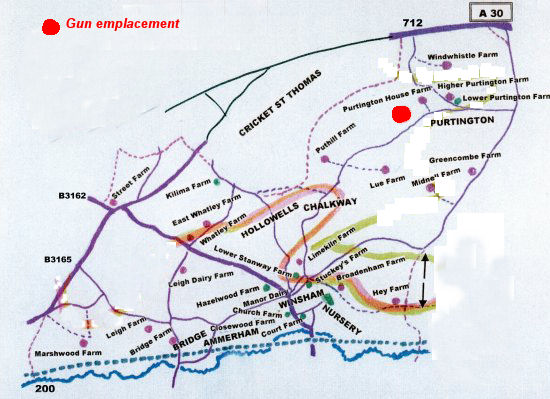
Anti-Aircraft Defence
If you leave Purtington, on Chalkway lane towards Green Lane
and Chalkway , on the right there was an Anti-Aircraft battery.
In WWII, a searchlight and and aircraft gun was installed in that area of
Cricket Thomas Estate which was then owned by Captain Hall. Army Nissen huts
were built and a section of the Royal Artillery lived there throughout
the war.
The system of searchlights and weapons across the section of S W England
stretched from Plymouth to Bristol in a pattern. In the early part of
the war with saturation bombing, this was the line of attack by German
bombers.
One night in 1942, a 1,000 pound German bomb was aimed at the gun site and
exploded in a field close to the road.
In that age Green Lane was a Bridleway which linked Chalkway Lane to the
main Winsham to Crewkerne Road. I believe that this is now closed off,
but in my childhood days it was an exciting short cut.
The
Normandy Landings 1944
During the late winter of 1943 and early spring of 1944,the estate took
on a transformation.
The time was approaching for the D-Day operation and the whole of South
West England was being flooded with soldiers and war machines on a
massive scale.
The whole of the wooded and grass areas to the north of Cricket House
(towards and following the A30 road) was completely taken over by men
of the
USA 29th. Infantry Division. The whole area was a tent camp
and well camouflaged by the wooded sections.
A few days before D-Day the 29th.started to move towards pick up ports
in the South West and South. At that time all the roads into Winsham
were, for days, saturated with men, vehicles and equipment moving to
take their place on the boats waiting in all the ports and small
harbours.
The mention of the 29th Infantry Division is because of its decimation
on landing. They were the first attackers on
Omaha Beach, Normandy at
07.00 on 6th. June 1944.Sadly,by 12 noon of the same day almost all of
the Division had been killed or washed out to sea by the incoming tide.
Most had only been soldiers for a few months.
Around Cricket St. Thomas Estate
Before Cricket St. Thomas became a theme park it was very much a
self sufficient estate --it operated three self contained farms with
dairy herds --it had its own saw mill operated by falling water
principle supplied from the flow from the lower lake.
Most important,
the Gypsy Families — Anna Isaacs and Bill Isaacs and their families
always wintered in Green Lane ,made wooden close pegs to sell in the
area and in Spring picked the wild daffodils --primroses and snowdrops
which grew in abundance. They then toured the villages
selling them by the small bunch.
Although they were more or less accepted to camp there, the local farmers
were not so
happy especially if they had winter crops of kale or swedes adjacent to
the lane.
It is worth noting as well that on a line south west from the gun site
towards the Cricket House —is a fairly large wood and just within its
bounds there was a small stone built one seat shelter —this is known as
Nelsons Seat —he often came to Cricket House to stay and could see his
fleets (apparently) through a telescope in Seaton Bay and the Bristol
Channel from the same spot !!
The Old Kings Arms
This was the most popular pub in the village, especially during World
War II. The Jubilee Hall was directly opposite and sometimes in those
days there would be dances on Wednesday and Saturday nights. The locally
stationed American troops and our local boys who were on leave would
take advantage and enjoy this function. Cider was the popular drink
which had disastrous consequences at times ( all types of beer of course
were on ration and in short supply).
On Water and Drainage!
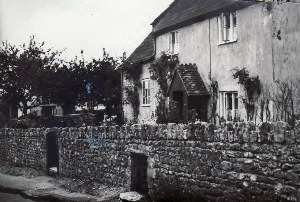
Photograph of
Percy Trott's home at top of High Street
Well before the start of World War II, the fresh
water supply to the top half of High Street, Back Street, Phillips
Farm, and the cottages on Chalkway Lane came from a spring at the top of
the junction of Broadenham Lane. The clue is the name of the large house
on the left of the road , still known as Springhead.
The spring water was funnelled down to a small brick reservoir opposite
the farm entrance to Stuckeys Farm from
there it was piped into an open brick tank shown near Percy Trott's home
in High Street and also to a stand pipe next to the thatched
cottage (Butlers) in Back Street. To obtain water from the open tank one
had to dip it out with buckets ( I remember it well, I lived just
around the corner in Back Street !). Halfway up our garden at Cobblestone
Cottage, we had a very deep well with a hand pump, but the water
was unfit to use for domestic purposes.
There were no utilities at all at the top of Back Street or Fore Street.
My home,
for example, had no electricity, water supply or sewer system. None
of this was available to us until well after World War II. All waste
water from these houses was taken by French drains down to an area in
the first field on the right, Coxes Close, where it dispersed over a large
area of the lower field.
Our toilet was the well known " Brick ------" and ours was located right
at the top of our kitchen garden
-I can I leave the rest to your imagination !!
A French Drain is something from the past; the system was to dig out a
trench about 12inches deep, then fill it with small stones. The turf
was then put back on. You then have a good drainage
system, providing it runs downhill, taking water waste
away.
Something for the Kids
The amusing thing I remember about that time was the main games (apart
from football) that us kids played . One was spinning tops, out on the
road. The 'top' consisted of a small two inch high wooden item sharpened
into a point with a boot stud at the point. The whip , a length of
string, was wrapped around the top. The top was then placed on the road
surface and the wound whip pulled sharply and, with luck off the top
would spin. You kept it going by continued whipping !
The
second time consumer and diversion was the iron hoop For a shilling,
Fred Churchill would blacksmith a hoop in small gauge round iron. With
this, he forged an iron rod with a hook at one end; the hook fitted onto
the hoop. By pushing on the hook, off one went. Races took place with us
children, up Back Street into High Street down Fore Street into
the square and back up to the finish !
Remember that at this time we had few motor vehicles.
During World War II any boy over the age of twelve ( providing that a
farmer could use him) was granted 10 days a year from school to help on
the land. I had a blue coloured card and Joe Phillips signed it as and
when.
The Strong Arm of the Law
In
the picture, 'Tiny' Weaver the Village policeman is
sitting on his cycle outside Mr. Warren's butchers shop which is visible
with a white frontage.
Tiny
Weaver took over the Winsham beat from a PC Redaway--there was no Police
Station then as such and they both resided as lodgers in Mrs. Courtney's
Farm across the road.
The first Police Station was across the road
from
Winsham Shop, but that closed in the mid 1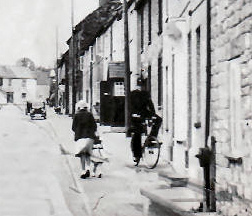 920s.
After that the village had to wait another twenty years before a new
facility was built. This was located on the edge of the
Chard Road at Bakersfield. Joe Burton was the first officer to occupy
the new station. Joe was a respected boxer and he boxed on the same
program as Freddie Mills, later to become the World Light Heavyweight
Champion (1948-50) - in 1945 at the hangar in Denning's Works in Chard
(and I was there with my Dad )! 920s.
After that the village had to wait another twenty years before a new
facility was built. This was located on the edge of the
Chard Road at Bakersfield. Joe Burton was the first officer to occupy
the new station. Joe was a respected boxer and he boxed on the same
program as Freddie Mills, later to become the World Light Heavyweight
Champion (1948-50) - in 1945 at the hangar in Denning's Works in Chard
(and I was there with my Dad )!
Tiny
Weaver was the first officer in Somerset Police to be issued mechanical
transport . How many remember the Indian motor cycle ? It was a massive
machine with a hand change gear stick and coloured maroon.
(I still have a photograph of one.)
When
I joined Somerset Police Tiny Weaver was the officer in charge of the
Bishops Lydiard Beat. and Joe Burton was a sergeant in the Information
Room at Headquarters, Taunton.
Winsham Characters
I
grew up knowing all the Butler family well--Molly and Betty were
twins and very smart lovely girls, serving in the WAAF during the
war. Joyce was next in line and she is still up and running. Freda was
next down the line and Eric the youngest. They were always very happy
and had a lot of fun. Eric
was a few months younger than me but we grew together as a great
partnership as you will discover later in these reminiscences.
Jack Butler was the father of the family.
He
worked for the then Chard District Council on roadwork and the like.
.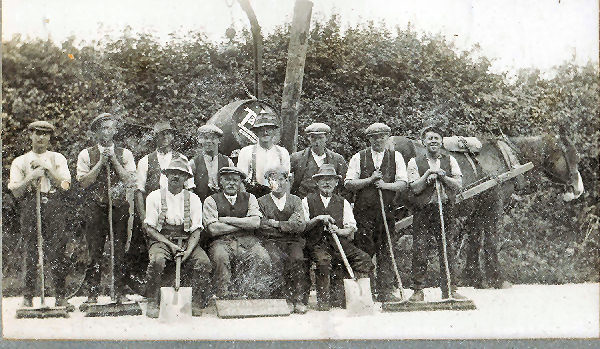
Winsham's
Tar Gang maintained the roads around the parish-something
that is needed in 2013!
Back Row: Ted
Dunford, Harry Chubb, Jack Butler, Tom Miller, Reg Grabham, Charlie
Spurdle, Ern Miller, George Morton. Front Row:
Reg Spurdle, George Chubb, Charlie Beer, Willy Webber. The horse
was owned by George Bishop, but it's name is not known. One member of
the team is missing from the picture above. Bert Spurdle was the Steam
Roller driver for Chard Council Roads Division
He
was always in the foreground of the road tar and gritting gang,
although in the picture above he is in the back row!
Pat Wheaton
Pat Wheaton
was another well known character- larger than life. His presence in a crowd always stood out.
But the notes in the Web Museum section showing photographs of Winsham
in 1938 are not quite accurate.
Ammerham Farm was never owned by Pat Wheaton or Roy Wheaton.(See
below. Ed.)
Ammerham Farm was farmed before the World War II by Roy Loveridge and
his father, that is the building in the foreground; down the hill
turning left into the old lane was Ammerham Mill ---I believe the Mill
Leat is still there. This
was also a dairy farm run by the
Pattimore family.
Pat Wheaton bought the house further back towards Winsham ( not in
sight) which used to be Manor Cottage. He ran his earth moving business
from there and owned the fields right through to Winsham cemetery.
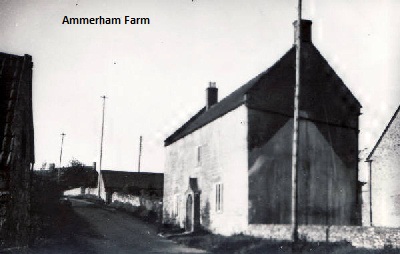
In
the field adjacent ( behind the house ) he had a purpose built
explosives store. When working on building new aerodromes, he used
gelignite for blasting tree stumps etc. Pat was a lad!
He
had a business slogan on all his bulldozers etc; " WE WILL
MOVE THE EARTH FOR YOU "--they were all painted bright yellow and a
soldier who was stationed in Malta during the war sent him a message, by
mail I think ,saying ---COULD HE MOVE MALTA A GOOD BIT CLOSER TO
ENGLAND !!.
When Pat married his second wife she brought her father from Cornwall to
Winsham and bought the adjoining cottage to our home in Back Street. He
was a lovely old man and always wore an old trilby hat.
He visited Pat at Ammerham one day and Pat, in one of his merry moods
took his father in laws hat and put it on the inside window sill, loaded
his shot gun and blew it to pieces ! But it didn't end there - the
blast blew the glass out of the window and shot went across the road and
through the window of Cyril Sawyers house !!
The
second panic that I remember is when he cleared the George Hotel one
night during his " I WILL MOVE THE EARTH FOR YOU " days. He was in the
bar and threatened to throw a 4 ounce stick of gelignite, which he had
in his pocket, into the fire! The rest one can imagine!
Editor's Note: So much for Health and Safety! The mind
boggles! Shot guns and gelignite! These days somebody would have
snitched, using their mobile phone, and an armed Terrorist
squad would have been there inside ten minutes .Well ,half an
hour anyway! Things ain't what they used to be - probably just
as well! Talk about the Wild West!!
With regard to the 'who owned what' controversy, this
was the first time
anyone challenged the accuracy of information in the Winsham Web
Museum. The original information was also from a reliable source. So I
asked if anyone could add anything to settle the matter.
Well they did. I had an e-mail from Bob Warren who confirmed
Dennis's assertion. Bob used to deliver meat from his father's
shop to most of them! |
The Churchill Family and a war time reminiscence.
Fred the father was the blacksmith and when he retired then so did the
blacksmithing !!
He had two sons and a daughter, Ned and Charlie Churchill, and
daughter Muriel.
Charlie Churchill never took part in the blacksmith repair/ farrier
business. He lived in Church Street, near Warren's butcher shop.
He worked as an engineer at Salter & Stokes butter factory and later at
the United Dairies Factory where he was in charge of the workshop.
Charlie was a fluent cornet player
and was bandmaster to Winsham Band during the World War II.
Charlie had a son, Jack, and he was really the expert in the
workings of these modern radio receivers.
He
worked at the Fore Street workshop and was an up to date expert in radio
mechanics etc; I have already said that he was the first person to
bring television to Winsham and used Peadon's Cider House in Back
Street
( next to Ivy Cottage and which no longer exists) to bring the first TV
pictures . This was via an experiment unit that he built from
scratch, I remember the day well- the first TV pictures ever to be
received in Winsham.
I
remember that my Mum & Dad bought a most up-to-date Cossor radio from
Ned and this was a source of great interest to my family except
me, although I remember one was the broadcast by Winston Churchill when
France capitulated in the early stages of World War II-all of us
huddled around the wireless- because of the seriousness of his speech (
how many of us remember how serious the situation was?).
Winston said----" WHAT GENERAL WEYGAND CALLED THE BATTLE OF FRANCE ,IS
OVER . I EXPECT THAT THE BATTLE OF BRITAIN IS ABOUT TO BEGIN....."
I
have a vivid memory of what happened as soon as those words were said.
.My mother kept items of food that needed protection in a small
wooden and gauze covered safe(our cottage remember had no
electricity and no water supply ). She went up to the safe,
and brought down a packet of sweets which she had hidden away and said
"HERE SON,HAVE THESE, BECAUSE THE GERMANS WILL BE HERE IN THE MORNING".
The seriousness of what she said of course never entered my head...
Click
HERE for more information about Jack Churchill and his Radio and TV
initiatives.
Ned never married; he was a great trombone player in Winsham Band. He
seldom did any farrier work-and was in his element with agriculture
machine repairs and the then recent innovation of radio and all the
related items such as large batteries and secondary electric supply,
acid filled accumulators, etc.
A Working Partnership
Eric Butler and I were great friends.
We were aged about 11 years in 1940, both attending Chard Holyrood
School. Together we had two small helpful businesses going from our
homes.
Some of the wooded areas and open wild areas were plagued with wild
rabbits and the farmers were pleased to have both Eric and myself to
catch them .
We worked as a team and kept our own ferrets at home. Once a week we
would ferret a chosen patch and the rabbits we caught were very much
sought after by households locally. Fresh meat was almost
non existent on ration, so we sold the rabbits at a shilling a
time. We returned later in the week to collect the skins because
Charlie Wooten, who had a greengrocery and fresh fish business in
Crewkerne would drive his van down to us once a week and pick up
all the skins for a 1d each.! They were sought after in the
clothing industry at
that time.
Our other money spinner which was more important was that of mole
catching.
Moles on pasture land at that time were a menace to farmers.
We ran two strings of mole traps, one mine and the other Eric's,
but we worked as team.
I can remember two farmers for whom we controlled the pests; one was
Farmer Knowles, whose farm was on the left down the hill towards
Whatley Cross. The other was Herbie Wheaton --his farm was Court Farm at
the bottom of Church Street.
When caught, and we used to check our traps daily after school,
the tail was cut off the dead mole. A penny a tail was the going
price from the farmer. We would then return home to remove the mole
skin, nailing them squarely on to large boards or the back of shed
doors to allow to dry. This is the important part, we had a small
contract with an animal skin merchant, who would buy them. They were
then used to line
the flying jackets of the pilots of the Lancaster Bombers. All
part of the war effort !
The Horror of War
I attended Holyrood School, Chard, after the first years at Winsham
Primary. We school children were transported by bus into Chard and home
at evenings each day. The journey I remember most vividly was on Friday 23rd.
October 1942. At about 4pm the bus full of us scholars were journeying
down the hill from Street towards Whatley Cross, where some children
would be dropped off. In the field on the right as we came down the hill
was a farmer ( I don't remember who) working in the field with a
tractor.
At the same time a German light bomber plane came over the wooded area
and fired a short burst of gun fire at the farmer turned sharply and
flew off in the direction of the coast. The plane was a JU 88 medium
bomber.
When we left the bus at Winsham, I turned the corner into Back Street to
see my mother in the doorway of our cottage, beckoning frantically
for me to hurry. This
a good place to say that my father was the cream and butter department
manager of the Chard Junction factory, and my sister worked as a packer on one
of the butter wrapping machines.
My mother was in a panic and told me that the
butter factory had been
bombed. Quickly, I got out my bicycle and set off to Chard
Junction , some 3 miles away.
On the approach to the factory entrance is a farm with one of its wagon
houses located on the left of the roadside.
I stopped and looked in. I was shocked to see perhaps ten young women
huddled up together. Most of them with their white overall coats covered
in blood !
My sister was with them and she had several serious cuts on her face. I
remember a piece of glass still embedded in her cheek. Nearly all of the
injuries to staff were caused by the shattering of the glass in the
partitions that separated the workrooms.
I then cycled into the yard of the factory, and saw the devastation.
There was a body still lying on the side of the yard.
Almost at once I saw my Dad at the bottom of the yard. He hurried over
to me and hustled me away from the scene.
Four bombs were released from the JU88. Because of some fog at the time,
the plane was so low that when it released the bombs they followed
a flat trajectory. One exploded in the field in front of the factory,
the second hit the concrete yard and bounced through a partition into
the interior butter churn room, but it had a delayed fuse and exploded
when some of the workers were back in trying to establish some sort of
order. The third and fourth bombs struck the concrete roof of the
factory and flew over the railway line and Chard Junction Station and
exploded in the football field beyond Bradford's Yard.
As for the injured, we forget the efficiency and resources of our
present Emergency Services. They did not exist on anything like the same
scale in those years.
Aid would have to be carried out by registered first aid employees of
the Company and with one ambulance perhaps in the whole district ! The
injured would have eventually been transported to the nearest emergency
centre by other vehicles. I would hazard a guess that the nearest one
was Taunton East Reach Hospital - now closed.
My sister, Noreen, was taken eventually to hospital to remove the glass
slivers were embedded in her arms and face.
She was off work for a long period, about three months, I think. Part of
the problem was loss of confidence in case the same occurred
again.
My Dad, to my mind, shrugged it off as one of those things to expect in
war. He did not delay in going back to work.
Butter production was shut down for months. The greatest problem was the
shattered glass that I mentioned earlier. All the butter making
churns-there were nine of them, were made from American Cedar. These
were peppered with glass particles. This was just one of many problems.
.jpg) |
On
21 February 1951, my father was awarded the British Empire Medal for his
part in the massive production of butter that supplied the armed forces
during the war, and the achievement of his butter producing staff, who
achieved a world butter production record of 300 tons in 24 hours. |
.jpg) |
Dennis,
after being demobbed from the RAF Regiment, joined the Somerset
Constabulary (now Avon & Somerset Constabulary) where he served
for twenty five years. He now lives in retirement with his wife
Pat, on the edge of Dartmoor. |
First published March, 2013
Dennis Summers passed away on the 22nd
February, 2017
|
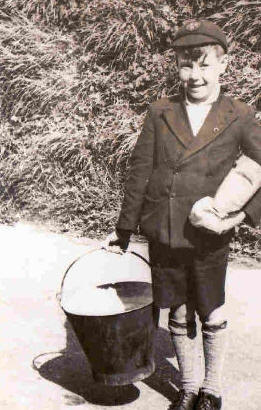


 920s.
920s.


.jpg)
.jpg)